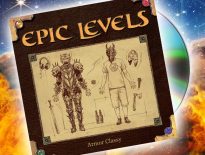So I recently watched some of the PR stuff for wizards Spelljammer boxed set, which at the time of writing is the latest D&D release.

During the interview, Chris Perkins, one of the chief developers, said that he’d written each chapter of the adventure to end on a cliffhanger like a Flash Gordan serial. He pitched it that this was new development in adventure writing and a change from the normal.
This assertation hit me like a cold shower.
I’d say on average, around 50% or my sessions end of some kind of cliffhanger moment, revelation or entrance. I’m sure I’m not the only one. That Wizards have literally never provided this as a format made me realise that either the whole play experience they expect is different to the one I am delivering, or they have misunderstood how most GMs structure a narrative.
While the researcher in me wanted to canvas GMs to find out, it also made me realise another thing – we’ve never talked about structure when it comes to the nitty gritty of a game; how to build and run a session, how to build and run a campaign. This is quite a complex thing and there’s never any solid advice on it. It’s just sort of ‘let players play, deliver consequence’. We don’t talk about what that actually entails.
So, I’m going to lay out how I think about this before and during a session. Because pacing is so very important.
The ‘NSS’
So, I’m about to introduce a structure that I use for a sort of “standard session”. It’s important to note that this is just the pacing I use for a game session that is running in a moment of exploration, moving the story forward. I don’t use it every time.
Recently I had a very slow session of downtime that featured just the players leisurely meeting people and playing with baby Ents. I also had a session that was set during a war that began with one player making death saves and didn’t let up the whole time, just explosions, people dying and not letting up the pace over and over for three hours until the players were exhausted. So there’s wide room for variety. But when I am thinking about each session, this is where I begin. Let’s call it a ‘narrative session structure’ or ‘NSS’ for the purposes of reference in later articles.
The NSS follows a distinct pattern and it broken up into 4 modes. Viewing a session in this way allows us to present a story in an engaging way for the players and allows us as GMs to be aware of when we might just have a session stuck in one gear.

Mode 1: Resolution & Establishing The New Normal
Usually any session I am running, I begin with a recap so the players have time to review the last session and establish where everyone is both in the narrative and geography of the story. Then I will spend the part of the session resolving anything that happens and establishing the place the story is now. If there was a cliffhanger, this is where I tend to put the fallout of the cliffhanger and whatever action results from it.
The important thing to put here is something that either moves the plot forward or is action orientated, as it allows a group of players some direction and focus early on. This momentum then carries them forward.
During this section, the session should be fairly straightforward in terms of your input: you’re showing the group a list of options and allowing them to dictate what sort of session they are likely to have. Wrapping up, resolving and meeting some sort of obstacle.
Mode 2: Explorative Phase
This is the moment the group have chosen what to do with the new normal. It’s the middle of the session and they’ve got a chance to really spread their wings and deal with a problem.
As a GM you’ve now shifted to just letting the story develop in whatever direction the players want to go and show them how these actions change the world they inhabit. Perhaps they’re interacting socially, exploring a city, clearing out dungeon rooms or hacking a computer system in a bank. Here the play is wide open and could go anywhere. You’re allowing the narrative to be free. But you’re also looking for a tipping point, a moment where things shift.

Mode 3: The Rising Action/Narrowing
Some way through the session, the choices they’ve made so far will result in a moment where neither the GM or the players are fully in control of the story – the session is going in a certain direction and then you have to follow it.
Perhaps the group have got themselves in trouble, perhaps they have found something to investigate that they didn’t expect, perhaps an important NPC has died. Or maybe it’s not dramatic but clear exactly where the story is going.
At this point it’s your job to focus the game in that direction and leave the other narrative threads for another time – give the players a way of looking back at the session and knowing what it was about. It’s worth mentioning if you want to drop any big explosive moments that need some time to cope with, it’s worth considering them in this section.
The pace in this section can sometimes be hurtling towards some kind of conclusion.
Mode 4: New Threads
In the last section before the session ends, it’s always good to give players a reason to stay intrigued or come back.
Introducing something that changes the way the group think about things or a cliffhanger, or just a new direction for the next session is a great way to do this. Having some idea of foreshadowing or some kind of idea of how the narrative might go s comforting to players at the end of the session. Remember, it can always be a mislead when you come back but giving them something to go home on is always a good touch.
Now, it’s not always possible to get through these four modes in every session. Some sessions will be just modes 1 & 2 and end in a comfortable place. Other sessions will be all 3 and just hit the players with important decisions as they hang on to the slide down the narrative hill. But being aware that the mode exists helps us to make that decision because it serves the story, not because we haven’t paid attention to the pacing. Awareness of how and where we are in the narrative of our session and comparing it to the time you have left at the table is really important. Just doing the same thing all session is going to grate some players, so let those modes change.
Next time we’re going to look at how pacing might apply to a less Narrative structure, like, say, downtime, and how to make your shopping trips be a much more memorable experience!
🤖AI Disclosure. Software helped create images in this post. Geek Native's AI Content Policy.

